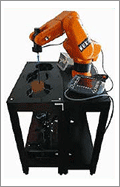 |
|
 |
| |

|
|
| COMOSAR TWINS |

|
6 a x i s |
|
| |
FULLY COMPLIANT
COMOSAR TWIN 6 axis has been developed to perform SAR measurements
for the certification of handsets in full compliance with the following
standards:
- IEEE 1528-200X,
- FCC OET Bulletin 65 (Ed. 97-01) Supplement C
- IEC 62209,
- EN 50361:2001
|
| It can perform measurements
at the GSM1800 (1710-1785 MHz), GSM1900 (1850-1910 MHz), USPCS (1851-1909
MHz), KPCS (1751-1779 MHz), WCDMA (1920-1980 MHz) frequencies (additional
bands are also available). |
| |
|
CUSTOMIZABLE
|
In order to address the increasing
time pressure on R&D, particular attention has been given to make
the system fast and user friendly.
The extensive list of GPIB instrumentation drivers in the OPENSAR
software (including R&S, Anritsu, Agilent, Willtek, Wavetek equipment)
can be customized upon request to include additional drivers for your
Instrumentation:
|
- Signal generator
- Power meter
- Base station simulator
- Vector network analyser
|
| COMOSAR with SAM phantom. The system can
also be packaged with flat phantoms (see datasheets). |
| |
USER FRIENDLY
|
- 3D graphic display shows scan progress during measurement
- Liquid permittivity measurement is an optional OPENSAR software
module. Measured permittivity values are imported directly in
the main SAR S/W
- Totally passive measurement chain to reduce deviation
- Automated measurement reports generated in Word or HTLM format
|
FAST
|
 The
system can measure 3 GSM channels at once (through automated GPIB
control of BS Simulator) The
system can measure 3 GSM channels at once (through automated GPIB
control of BS Simulator)- User selectable scan paths for optimal measurements
- User selectable scan steps
- User selectable interpolation algorithms to speed up the overall
measurement time
- Measurement time for one configuration can take less than 5
minutes
- Real time E-field values ACCURATE
- High sensitivity probe, does not require amplification
- Passive measurement chain for less E field disturbance
- Probe made of high permittivity material to minimize E-field
disturbance Customized solutions for antenna design and measurement
systems Batiment Ponant, Avenue la Perouse, Brest Technopole Iroise
29280 Plouzane, France.
|
HIGH REPEATABILITY
|
- Device and measurement set-up saved in software database
- Reference points for phantom and probe positioning
- Device positioning system fixed on a rail with precision >
1°
- Switching from the cheek to the tilt position in one move COMPACT
- Light robot (25 KG), no ground reinforcement required, single
phase power supply
- One table compatible with all phantoms, external dimensions
with one phantom 1mX0.9m, with 2 phantoms: 1m X 1.40m FLEXIBLE.
- SAM phantom, head phantom, flat phantoms for handset and base
station.
- Possibility to use two phantoms with one robot (Quad System)
- The hold of the device positioning systems can be adjusted to
handset, walky-talkies or PDA.
|
EASY TO HANDLE
|
 Instruments
controlled centrally thanks to GPIB bus Instruments
controlled centrally thanks to GPIB bus- Phantoms’ material easy to clean and equipped with a tap to
empty liquids
- Probe connector with a screw for easy mounting PROFESSIONAL
SERVICES
- One year warranty on ANTENNESSA components, including technical
support
- 2 working weeks turnaround time for probe calibration by ANTENNESSA
- Support for installation and training
- Possible customization of the system on demand
|
The standard kit
includes: * See separate data sheet for more information
|
 KUKA
KR5 6 axes robot* KUKA
KR5 6 axes robot*- OPENSAR* software
- Keithley multimeter*
- GPIB Card
- 2 x E field probes*
- SAM Phantom*
- Device Positioning System*
- Liquids
- Validation dipoles*
|
Additional required
equipment:
|
- Network emulator (BS simulator)
- Liquid permittivity measurement kit (ANTENNESSA)
|
Optional additional modules:
|
- Extra table / phantom / positioner (Quad system)
- HAC bench
- CALISAR
|
| |
|
|



 The
system can measure 3 GSM channels at once (through automated GPIB
control of BS Simulator)
The
system can measure 3 GSM channels at once (through automated GPIB
control of BS Simulator) Instruments
controlled centrally thanks to GPIB bus
Instruments
controlled centrally thanks to GPIB bus KUKA
KR5 6 axes robot*
KUKA
KR5 6 axes robot*